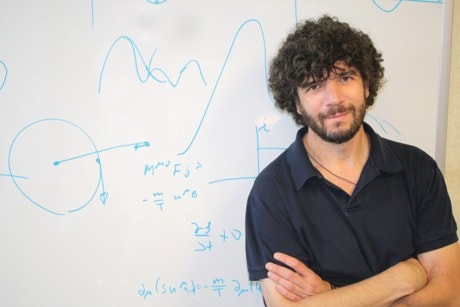Growing up in a small town in northern Argentina, Julio Navarro would sleep outside on the patio with his family after days in which the temperature hit 45 C.
As a young boy he would wake in the night to watch the star-filled sky.
“The patterns changed all the time, sometimes here and there, but changes in a clockwork fashion. I thought it was fascinating,” said Navarro.
Now an astrophysicist at the University of Victoria, he attributes those nights on the patio with instilling in him a love for the stars. He went on to receive a PhD at Harvard University and did post-doctoral work at Cambridge University in England before being hired at UVic in 1998.
In November he will head to Ottawa with UVic geologist Dante Canil to be inducted into the Royal Society of Canada.
The society is also awarding UVic climatologist Andrew Weaver the 2011 Miroslaw Romanowski Medal for his research, writings and sharing of his work on climate change.
The society, which honours outstanding scholarly work in the arts, humanities and sciences, is including Navarro because of his research, which includes the study of dark matter, a “mysterious substance in the universe.”
His work involves building computer simulations to hypothesize about what building blocks make up the universe. The answers, he said, would increase our knowledge of physics. Although humans know enough to build bridges or even ascertain the age of the universe (13.5 billion years), we don’t know the mechanics of how the universe came to be, Navarro said.
“For example, this dark matter, we don’t even know what it is and yet it’s mixed with most of the universe,” he said. “And the Milky Way, whose stars go around in a plane – why that shape, why not a different shape? And why are there 10 billion stars and not 200 billion stars?”
Those are the kinds of questions Navarro builds simulations for. They run in large computer systems in Europe, he said – “the biggest that academics have access to, sometimes 10,000 linked together that run without stopping for months.”
Cosmology is in its golden age, he said. Scientists understand things about the universe, such as how it began, that were unknown just 30 years ago. “Now there is fairly good agreement within the (astronomy and physics) community that the Big Bang did exist and that it can be measured with accuracy.
“This is an astonishing result. A hundred years from now scientists will look at this time and say ‘this is when cosmology grew into a mature science.’”
vmoreau@oakbaynews.com
Did you know?
• Formed in 1883, the Royal Society of Canada (www.rsc.ca) is an academy of more than 2,000 distinguished scholars, artists and scientists chosen by their peers. This year 75 fellows will be inducted and 12 others will receive awards.
• UVic geologist Dante Canil is being honoured for his research into the Earth’s mantle. His work has expanded knowledge of where diamond deposits are concentrated.
